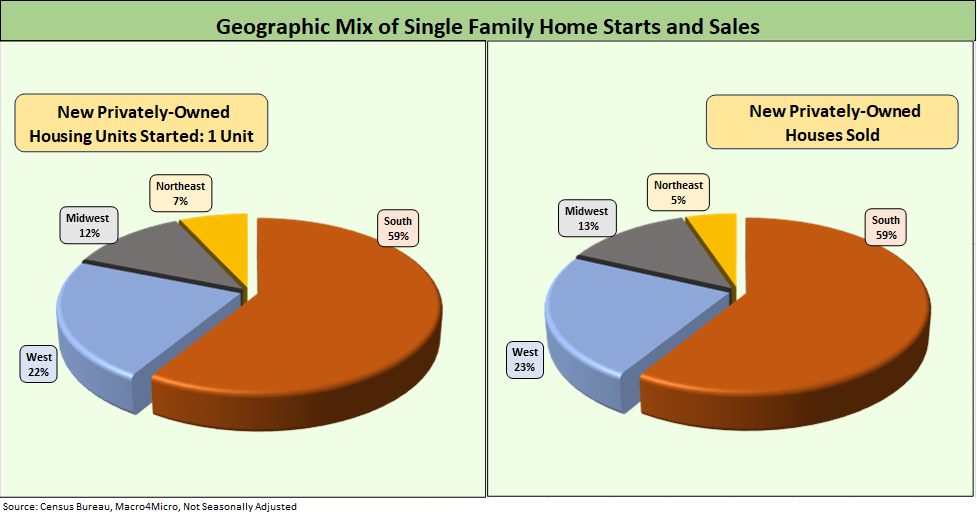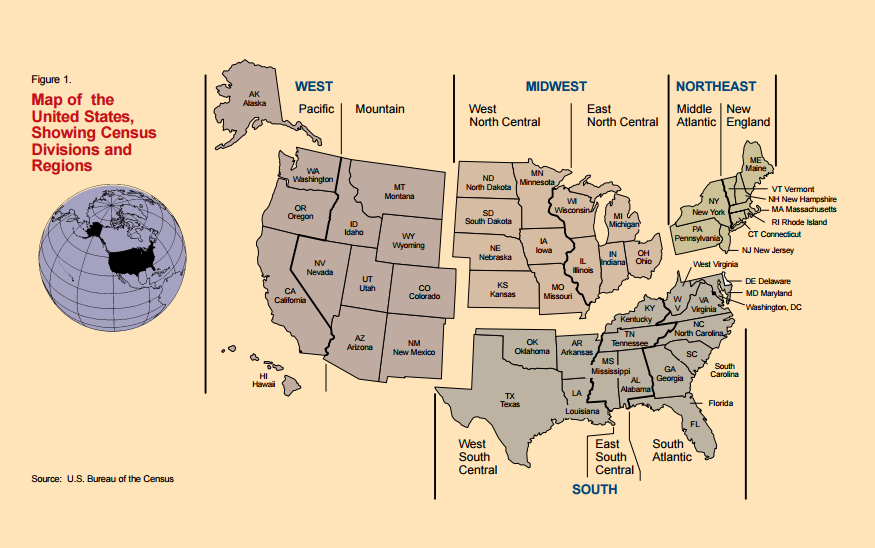Harris Housing Plan: The South’s Gonna Do It Again!?
The topic has not come up in the headlines, but the biggest beneficiaries of the Harris housing plan would be the South in line with her “all people” theme.
When it comes to framing the benefits of a potential Harris housing master plan, there is no denying that by far the biggest housing markets – whether existing or new or across “starts” (construction activity) are in the South. That region is anchored by Texas and Florida with growth opportunities across the Sunbelt.
In this note, we look at the regional mix of existing home sales, new home sales, and housing starts that drive so much activity and employment with material economic multiplier effects. The Harris housing plan falls under her pitch as “President for all Americans” even if a comprehensive housing plan would cater to a lot more red states in the single family mix.
The “evolving” Harris plan for housing is a bold stroke that the GOP can trash talk, undermine, or embrace as a bipartisan issue that flows into one of the top problems of the day as stubborn shelter inflation and supply-demand problems will require years to deal with given the complexity of the challenge. A plan needs to start sooner rather than later with a close eye on any distorting effects.
The flip side of the risk is that the progressive wing keeps attacking the private sector links to housing by seeking to limit capital flows and looking to take action that will curtail incremental housing supply in a sector that needs all the supply that it can get – whether to own or rent.
With shelter inflation the most stubborn metric and demographic supply-demand imbalances prevailing, a viable housing plan will take a lot more than a white board, and Harris could in theory rival Obama’s health care focus, Trump’s tax cuts, and Biden’s environmental initiatives for an issue to define the Harris campaign and her run for office.
In this commentary, we have the low-ambition goal of framing the geographic mix of home sales, new single family home sales (1 unit), and the mix of home starts by region. With a Harris housing plan slowly taking form, the frame of the end markets should be kept in mind to assess the political X factors of “who benefits” more than others in the various regional economies.
The above chart breaks out the regional mix by price tier for existing family homes. We look at existing home sales with each monthly release (see Existing Home Sales July 2024: Making a Move? 8-23-24), but the above mix reconciliation is not part of the usual recap. We detail the price tiers on the bottom (e.g., $250K-$500K) and then show the unit sales mix in the 5 bars above those price buckets. We do one bar in each from left to right – 1 for the US overall and then 1 bar from left to right for each region South, Midwest, West, and Northeast.
In the chart above, you add up the weighting of each region in each bucket and the total for the US (around 100% for each with some rounding per the NAR), you see the price tier mix for the region. Example: in the $100K-$250K bracket, the Midwest posts over 30% of its sales in that price tier, then 45.5% in the $250-$500K range, then 12.3% in the $500-$750K range, etc. Note in the map at the top and bottom that the Midwest is heavy on rural and exurban in some states.
For the South (by far the largest new home sales and starts market as detailed further below), we see that 52.3% of existing home sales in the South is in the $250K-$500K bucket of existing home sales. The West can be seen generally as very pricey given the selling prices in California and notoriously high regulatory costs so often cited by the builders. The Harris bill is at the federal level, so the question of the more daunting state and local costs will need a lot of explaining as this unfolds.
While it is not clear who will be the main target for support yet in terms of eligibility, we see a reasonably balanced mix in the two lowest price tiers with the Midwest region materially higher in the $150K-$250K bucket. The South and the Midwest regions are more concentrated in the $250K to $500K range, which is the price tier that comprises around 45% of total US existing home sales.
The trick by region and especially as you get into the large MSA suburbs will be where the Harris plan might draw the line on what price range needs support and what type of residence from single family detached to single family attached to multifamily.
For existing home sales with its many low-priced homes, there is a lot of room to maneuver. If the goal is to expand the housing stock and supply of new homes to eat into inflation, then the geographic mix is more about starts and new home sales as we break out in the next chart. Lower mortgage rates are more important to increasing the supply of existing homes available for sale since so many owners are locked in with low mortgages and are not selling yet. More sellers would ease supply and demand pressures and in theory shelter inflation would moderate.
The above chart shows the regional mix for new single family homes and also details the regional mix for new home starts. One metric (new home sales/closings/deliveries) feeds the other (starts) as part of the working capital cycle as builders look to prudently manage their inventory.
The chart shows over half the activity on a national scale takes place in the “South” region as defined by the census. The South includes Texas and Florida with Florida generally a higher price market for most of the builders and Texas much lower given the very diverse nature of the Texas markets. Austin and Dallas are obviously very different from more remote West Texas markets (see links at bottom for some single name research on major builder price ranges).
The new residential construction side of the equation is where the Harris plan gets very tricky. If you can view existing home transactions as more easily addressed through down payment support and tax credits, etc., the action takes place in budget battles and cash support is more Washington committees. Even that is hard enough in a partisan backdrop as we saw “long ago” in health care. Things are much worse now than in 2009-2010 on partisanship hurdles.
When you start talking about new construction (the “3 million new homes” pitch), then you get into the far more complex private sector dynamics of homebuilders, supplier chains, available labor (skilled and semi-skilled), and gaining the confidence of subcontractors that build the homes to deploy/redeploy their resources from other activities (like private sector homebuilding).
The homebuilding sector overall and how that works in practice has been shown to be no easy task to master. Respecting the downstream execution risk and risks across sea level industry operations is not a typical Washington strength when it comes to thinking through those issues. Washington can spend, but execution in an area like this will be a massive challenge from funding to building.
The Harris plan is also getting married to some of the progressive attacks on builders (e.g., build to rent providers) and attacking capital flows into housing (notably funds that buy rental properties). We looked at some of those issues in our recent new home sales comment (see New Home Sales July 2024: To Get by with a Little Help from My Feds? 8-25-24). Just the title of the Senate bill “Stop Predatory Investing Act” sets the tone.
The simplicity of the corporate greed rhetoric getting worked into this housing plan essentially states that funds invest to rent gouge even though they are adding to the housing stock through the build to rent operations of the builders. Buying existing homes vs. new is a separate topic, but even with restrictions on buying existing homes, the effect would be to remove bids for potential sellers. That impairs options for a homeowner looking to cash out or move up.
New single family rental homes are part of a mix shift and have rental pricing dynamics to reflect that favorable trend in alternatives for the renter. From D.R. Horton to LGI Homes, builders are adding to the housing stock in such areas. Then rents are more market driven with new single-family construction being able to command more in rent than an apartment. In the end, the market needs MORE of everything to get inflation in check.
The Harris plan can shift the “rent vs. buy” economics but doing that by artificially reducing rental supply flunks the Econ 101 test. Supply growth will be constrained. That strategy will doom the plan’s end goal. Harris is more inclined to play ball with progressive partners on that bill. That is a mistake.
Housing matters to both parties…
The demographics of the US always make for “entertaining” comparisons across regions and within the various pockets of the US, including the urban, suburban, exurban and rural mix of Americans. Among the common interests whether in the GOP or as a Democrat is the reality of “ya gotta eat” and “ya gotta sleep.” That is where shelter inflation and food inflation come into play.
A focus on housing whether owned or rented is a great economic policy ambition in a cycle where shelter inflation is still dominating the monthly CPI release at almost a third of the inflation index mix (see CPI July 2024: The Fall Campaign Begins 8-14-24). It is clearly action, but it can’t be rooted in the blame game against builders and investors.
The South and swing states rule the roost in homebuilder leaders…
The homebuilder kings are typically based in the South and swing states, so their support will be crucial. The leading homebuilders include companies with headquarters in Texas, Florida, Georgia, Virginia, Pennsylvania, Arizona, and Nevada (only one in LA). These states likely ring a bell for most in handicapping the electoral college math.
The homebuilder leaders are based in states that would be good for a politician to work with constructively, but attacks on corporate greed by the Democrats are what the GOP is hoping the Democrats will be stupid enough to engage in when it comes to housing. Some pockets of the Democrats just cannot help it. Hardwired behavior is hard to shake.
Opponents of any plan that Harris launches will cite the complications of designing a single family housing plan that will make it fail even if there are ample rational solutions to start the process. We have already seen the naysayers just on the topic of defining what a “starter home” means. The housing sector has no shortage of objective benchmarks and regional variations to use in working through such issues (MSA price averages, FHA conforming loan parameters for Freddie and Fannie, etc.). There is hard data and no shortage of input to extract from the industry.
Beware political axes and formulaic left vs. right…
There will be a lot of focus on the headline Harris plan as it starts to get infilled with detail and Trump and the GOP weigh in. Meanwhile, it will be a challenge for the left or right to resist leaving their ideological scents on the hydrant.
For the right, they will aim at Harris plans as radical left Marxist, Communist, Socialist etc. etc. and the progressive wing of the Democrats will sing songs of greedy corporations and investment funds investing in housing (since deploying capital and investing in an expanded supply of housing is so evil).
The only vanguard one needs to worry about is not Lenin but the “vanguard” of the power hungry, narrow minded, and ignorant since those are the ones that would rather undermine progress in one of the biggest challenges of the current market, which is home prices, rents, and affordable housing. Harris has an opportunity to make it relatively nonpartisan as a concept and still position it with a left-of-center flavor. She could work with some moderates in the design as we saw with the infrastructure bill and others. After all, it is big money for the consumer and for the builders if it is structured the right way.
See also:
New Home Sales July 2024: To Get by with a Little Help from My Feds? 8-25-24
Existing Home Sales July 2024: Making a Move? 8-23-24
Housing Starts July 2024: The Working Capital “Prevent Defense” 8-16-24
Credit Crib Note: PulteGroup (PHM) 8-11-24
Credit Crib Note: D.R. Horton (DHI) 8-8-24
New Homes Sales June 2024: Half Time? Waiting for Mortgage Trends 7-24-24
Existing Home Sales June 2024: Supply Up, Prices Up, Volumes Down 7-23-24
Housing Starts June 2024: Still All About the Deliveries 7-17-24
Homebuilder Equities: “Morning After” on Rate Optimism 7-12-24
Homebuilders: Equity Performance and Size Rankings 7-11-24
Credit Crib Note: KB Home 7-9-24
Lennar: Key Metrics Still Tell a Positive Macro Story 6-20-24
Credit Crib Note: NVR, Inc. 5-28-24





